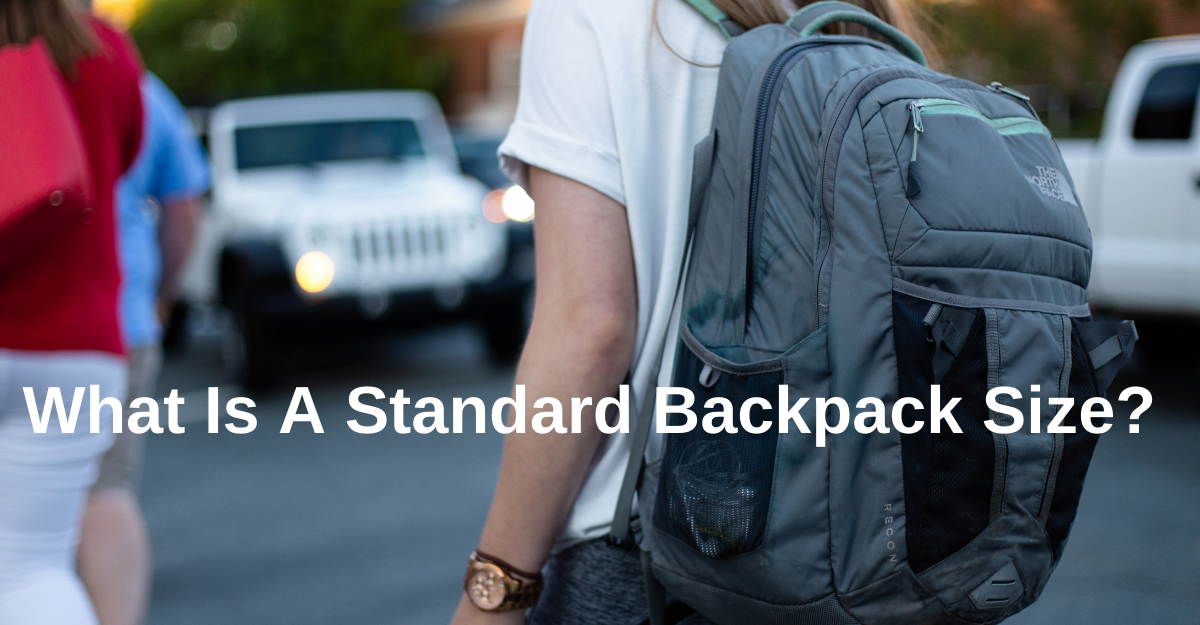
Standard Backpack Size
Standard backpack dimension can vary somewhat based on their intended use and the age group they’re designed for. However, there are accepted standard backpack size that cater to different needs and preferences.
The typical dimensions of an ordinary backpack are 22 inches in length, 14 inches in width, and 9 inches in height (or approximately 55.9 cm x 35.6 cm x 22.9 cm).
The standard backpack dimension typically range from 16 to 18 inches in height, 12 to 14 inches in width, and 6 to 8 inches in depth. These dimensions are commonly used for everyday use, work, or travel. They provide a good balance between carrying capacity and comfort, allowing individuals to store essentials without the backpack becoming overly bulky or cumbersome.
In the realm of school backpacks, standard backpack dimension tend to be slightly larger. This accommodates the textbooks, notebooks, and other school supplies that students need to carry. A standard school backpack size often falls within the range of 18 to 20 inches in height, 14 to 17 inches in width, and 7 to 9 inches in depth. This additional space is essential for students to organize their belongings effectively and avoid strain on their shoulders and backs.
Additional Dimensions for Standard Size Backpacks
Aside from the standard backpack size commonly used for adults, school children, and younger kids, there are other specialized backpacks with unique size considerations to cater to specific needs and activities.
Hiking and outdoor backpacks, for instance, have their own set of standard backpack dimensions. These backpacks are designed to accommodate gear and supplies needed for outdoor adventures. The dimensions for a standard hiking backpack range from 24 to 28 inches in height, 12 to 14 inches in width, and 8 to 10 inches in depth. This size allows hikers to carry essentials like clothing, food, water, and camping gear comfortably while distributing the weight effectively to prevent strain during long treks.
What size is ideal for a backpack that can be used daily?
Choosing a suitable size for an everyday backpack involves considering your daily needs and comfort while adhering to standard backpack dimensions. For most adults, a good size for an everyday backpack falls within the range of 16 to 18 inches in height, 12 to 14 inches in width, and 6 to 8 inches in depth.
These standard backpack dimensions provide ample room to carry essentials like a laptop, notebooks, a water bottle, and personal items, without feeling overly bulky. A backpack within these dimensions strikes a balance between functionality and ease of use, ensuring that you have enough space for your belongings without compromising on comfort during your daily activities.
When selecting an everyday backpack, consider the compartments and organization features it offers. Pockets, dividers, and compartments designed to hold specific items can enhance your ability to stay organized throughout the day. This further enhances the utility of a backpack within standard dimensions, allowing you to efficiently manage your belongings without unnecessary hassle.
Would a 30L backpack be considered oversized?
Determining whether a 30L backpack is too big depends on your specific needs and how well it aligns with standard backpack dimensions. A 30L backpack falls within the range of standard sizes and is considered to be on the larger side for an everyday or casual-use backpack.
Standard backpack dimensions for an everyday backpack usually range from 16 to 18 inches in height, 12 to 14 inches in width, and 6 to 8 inches in depth. A 30L backpack could potentially exceed these dimensions, which might result in a bulkier and more substantial backpack. A backpack’s size is not solely determined by its capacity in liters; the design, compartmentalization, and overall shape also play a role.
Is my backpack too big?

Standard Backpack Size
Determining if your backpack is too big involves considering various factors in relation to standard backpack dimensions. While a larger backpack can provide extra space, there are clear signs that suggest it might be oversized for your needs and comfort.
Check the dimensions of your backpack in comparison to the standard measurements. If your backpack significantly exceeds the typical range of 16 to 18 inches in height, 12 to 14 inches in width, and 6 to 8 inches in depth for everyday use, it might be too big. An excessively large backpack could lead to discomfort and difficulty maneuvering in tight spaces.
Another indicator that your backpack might be too big is if it consistently feels overly heavy when fully loaded. Even if a backpack’s capacity is within standard dimensions, a larger backpack tends to encourage overpacking, resulting in excessive weight. Carrying too much weight can strain your shoulders, neck, and back, potentially leading to discomfort or injury.
FAQs
What is the typical volume of a regular backpack in liters?
The capacity of a normal backpack is often measured in liters and is closely related to standard backpack dimensions. A typical backpack that is considered normal or average in size generally falls within the range of 20 to 30 liters in capacity.
When determining the appropriate capacity for a normal backpack, it’s important to keep the standard backpack dimensions in mind. These dimensions usually range from 16 to 18 inches in height, 12 to 14 inches in width, and 6 to 8 inches in depth. The capacity in liters correlates with these dimensions and accounts for the internal space available for storing items.
How would you define a backpack that falls into the medium size category?
A medium-sized backpack falls within a range of dimensions that align with standard backpack dimensions while offering a balance between carrying capacity and ease of use. Generally, a medium size backpack is considered to be in the range of 20 to 30 liters in capacity.
When discussing a medium size backpack, it’s important to reference the standard backpack dimensions, which range from 16 to 18 inches in height, 12 to 14 inches in width, and 6 to 8 inches in depth. A medium size backpack adheres to these measurements, ensuring that it remains manageable and comfortable for various activities.







You must be logged in to post a comment.